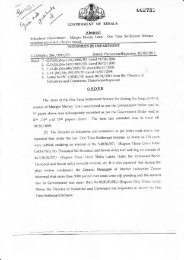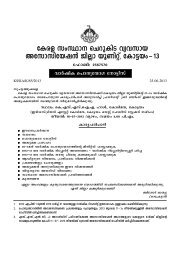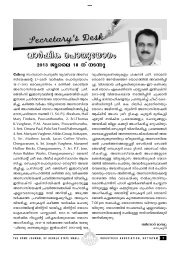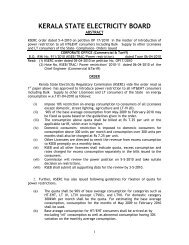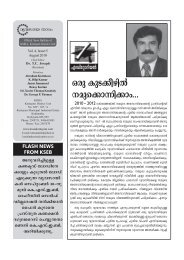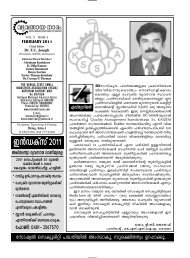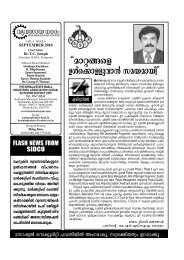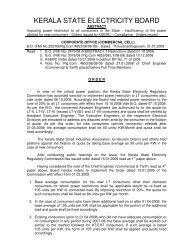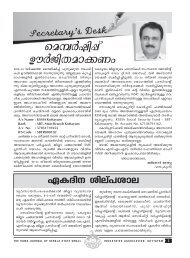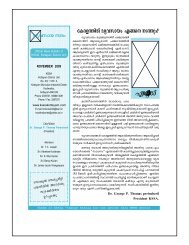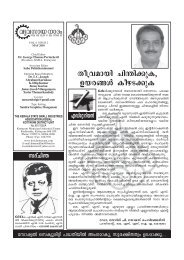Vyavasaya Nadham April 2013 - KSSIA Kottayam
Vyavasaya Nadham April 2013 - KSSIA Kottayam
Vyavasaya Nadham April 2013 - KSSIA Kottayam
You also want an ePaper? Increase the reach of your titles
YUMPU automatically turns print PDFs into web optimized ePapers that Google loves.
............................................................................................................................................<br />
hyhkmb\mZw<br />
It is a tool used by the teams to assist them in<br />
pursuing their objectives by carefully managing<br />
these four controllable variables to meet the needs<br />
of the defined target groups.<br />
The teams in Cesim SimBrand will have to carefully<br />
analyze the four available market segments in<br />
order to design desireable, correctly priced, well<br />
promoted, and properly placed products.<br />
9. Marketing Budgets<br />
There are a number if ways in which firms can<br />
calculate how much to allocate to their marketing<br />
and advertising spend. These methods are:<br />
The objective and task method<br />
Competitive parity method<br />
Percentage of sales approach<br />
Each of these can be applied in Cesim's marketing<br />
simulation, and then compared to measure the<br />
level of relative effectiveness to each other.<br />
10. Consumer Buying Behavior<br />
What influences consumers to purchase products<br />
or services? The consumer buying process is a<br />
complex matter, as many internal and external factors<br />
have an impact on the buying decisions of the<br />
consumer.<br />
When purchasing a product, there are several<br />
steps the consumer goes through. These are:<br />
1. Problem/Need Recognition<br />
2. Information Search<br />
3. Evaluation of Different Purchase Options<br />
4. Purchase Decision<br />
In order to capture a big market share, teams in<br />
Cesim SimBrand have to make sure that their offering<br />
is aligned with what the customers want, but<br />
are also susceptible to the possibly more desireable<br />
offerings of competitors.<br />
11. Market Segmentation, Positioning, Targeting<br />
The case company in Cesim SimBrand can operate<br />
in two markets, Europe and Asia. The markets<br />
are of different size and have different growth<br />
rates.<br />
There are four different customer segments in<br />
both markets (more detailed information in the<br />
marketing research report):<br />
Households<br />
High-end households<br />
Companies<br />
High-end companies<br />
The simulation game includes a product positioning<br />
tool that allows you to compare your own<br />
product positioning with that of the competing<br />
teams. Separate maps are available for both Europe<br />
and Asia.<br />
12. SWOT Analysis<br />
This tool is used by organizations to help the firm<br />
establish its Strengths, Weakn esses, Opportunities,<br />
and Threats. A SWOT analysis is used as a framework<br />
to help the firm develop its overall corporate,<br />
marketing, and product strategy.<br />
In the simulation this can be done after the first<br />
practice round, when the participants have been familiarized<br />
with the game environment, and then<br />
reviewed from round to round.<br />
13. BCG Analysis<br />
This product portfolio matrix classifies product<br />
lines into four categories. It suggests that organizations<br />
should have a healthy balance of products<br />
within their range. The classifications are:<br />
Dogs<br />
Question Mark/Problem Child<br />
Star<br />
Cash Cow<br />
Cesim SimBrand offers a great opportunity for<br />
students to practice this particular marketing concept<br />
by positioning their products accordingly.<br />
14. Product Life Cycle<br />
The product life cycle concept suggests that a product<br />
passes through four stages of evolution:<br />
Introduction<br />
Growth<br />
Maturity<br />
Decline<br />
The smartphones of the Cesim marketing simulation<br />
game follow this curve as well, thus illuinating<br />
the different strategies companies have to take during<br />
each phase of the cycle.<br />
15. Ansoff's Matrix<br />
A common tool used within marketing was developed<br />
by Igor Ansoff in 1957. He suggested that a<br />
business can grow in one of four ways, from the lowest<br />
risk to a high risk strategy of growth.<br />
These are:<br />
Market Penetration<br />
Product Developemt<br />
Market Development<br />
(Diversification)<br />
Although Cesim SimBrand doesn't allow for the<br />
diversification aspect of Ansoff's matrix (the companies<br />
cannot decide to start selling something else<br />
other than smartphones), the other three strategies<br />
can be pursued and practiced throughout the course<br />
of the simulation game.<br />
14 THE HOME JOURNAL OF KERALA STATE SMALL INDUSTRIES ASSOCIATION, KOTTAYAM



